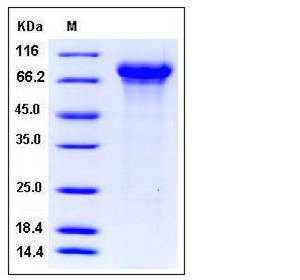Mouse KNG1 / BDK / kininogen-1 Protein (His Tag)
Kng
- 100ug (NPP3383) Please inquiry
| Catalog Number | P50474-M08H |
|---|---|
| Organism Species | Mouse |
| Host | Human Cells |
| Synonyms | Kng |
| Molecular Weight | The secreted recombinant mouse KNG1 consists of 471 amino acids and has a predicted molecular mass of 52.5 kDa. In SDS-PAGE under reducing conditions, the apparent molecular mass of rm KNG1 is approximately 70-80 kDa due to glycosylation. |
| predicted N | Glu 21 |
| SDS-PAGE |  |
| Purity | > 95 % as determined by SDS-PAGE |
| Protein Construction | A DNA sequence encoding the mouse KNG1 isoform 3 (NP_001095882.1) (Glu 21-Ser 480) was expressed, with a polyhistidine tag at the C-terminus and a signal peptide at the N-terminus. |
| Bio-activity | Measured by its ability to inhibit papain cleavage of a fluorogenic peptide substrate Z-FR-AMC (R&D Systems, Catalog # ES009). The IC50 value is < 5 nM. |
| Research Area | Cancer |Signal transduction |Metabolism |Pathways and Processes |Metabolism processes |Apoptosis | |
| Formulation | Lyophilized from sterile 20mM Tris, 100mM NaCl, pH 7.5 1. Normally 5 % - 8 % trehalose, mannitol and 0.01% Tween80 are added as protectants before lyophilization. Specific concentrations are included in the hardcopy of COA. |
| Background | Mouse kininogen-1, also known as high molecular weight kininogen, williams-Fitzgerald-Flaujeac factor, Alpha-2-thiol proteinase inhibitor, Fitzgerald factor, KNG1 and BDK, is a secreted protein which contains three cystatin domains. Kininogen-1 / KNG1 is a protein from the blood coagulation system as well as the kinin-kallikrein system. It is a protein that adsorbs to the surface of biomaterials that come in contact with blood. Kininogen-1 / KNG1 circulates throughout the blood and quickly adsorbs to the material surfaces. Kininogen-1 / KNG1 is one of the early participants of the intrinsic pathway of coagulation, together with Factor XII (Hageman factor) and prekallikrein. Kininogen-1 / KNG1 is one of the kininogens, a class of proteins. As with many other coagulation proteins, the protein was initially named after the patients in whom deficiency was first observed. When the clinical data were combined, it turned out that all patients, in fact, had a deficiency of the same protein. Defects in KNG1 are the cause of high molecular weight kininogen deficiency (HMWK deficiency) which is an autosomal recessive coagulation defect. Patients with HWMK deficiency do not have a hemorrhagic tendency, but they exhibit abnormal surface-mediated activation of fibrinolysis. |
| Reference |
